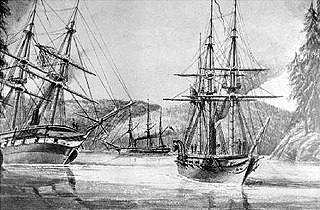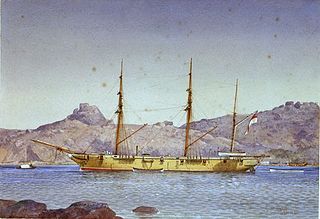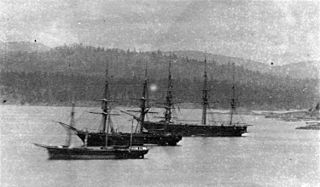
The Hecla class formed the backbone of the Royal Navy's ocean survey fleet from the mid-1960s.

HMS Gorgon was a wooden steam paddle sloop of 6 guns, launched in 1837. In 1840 she took part in the bombardment of Acre, and in 1843 was part of the Royal Navy squadron stationed in the River Plate during the Uruguayan Civil War. She was converted to a troopship and in 1858 assisted Agamemnon in the laying of the first transatlantic telegraph cable. She was sold for breaking in 1864.

HMS Plumper was part of the 1847 programme, she was ordered on the 25 of April as a steam schooner from Woolwich Dockyard with the name Pincher. However, the reference Ships of the Royal Navy, by J.J. College, (c) 2020 there is no entry that associates this name to this build. The vessel was reordered on August 12 as an 8-gun sloop as designed by John Fincham, Master Shipwright at Portsmouth. Launched in 1848, she served three commissions, firstly on the West Indies and North American Station, then on the West Africa Station and finally in the Pacific Station. It was during her last commission as a survey ship that she left her most enduring legacy; in charting the west coast of British Columbia she left her name and those of her ship's company scattered across the charts of the region. She paid off for the last time in 1861 and was finally sold for breaking up in 1865.

HMS Hydra was the lead ship of her class of wooden steam paddle sloops of the British Royal Navy, launched in 1838 at Chatham Dockyard. After taking part in operations during the Syrian War in 1840, she then served on anti-slavery operations and also as a survey vessel. She was scrapped in 1870.

The Algerine-class gunboats were a class of six 3-gun wooden gunboats built for the Royal Navy in 1857. A further pair were built in India for the Bombay Marine in 1859.

The Cruizer class was a class of six 17-gun wooden screw sloops built for the Royal Navy between 1852 and 1856.

The Rosario class was a class of seven screw-sloops of wooden construction built for the Royal Navy between 1860 and 1862. A further six vessels were ordered and laid down, but were cancelled in 1863 before launch. This was the last class of purely wooden sloops built for the Royal Navy.

HMS Niger was originally slated to be built as a Sampson designed sloop; however, she was ordered as a First-Class sloop with screw propulsion on 20 February 1845 to be built at Woolwich Dockyard, along the design developed by Oliver Lang and with a hull like the Basilisk designed paddle sloops. Her armament and engine were to be like the Encounter Design building at Pembroke. A second vessel (Florentia) was ordered on 26 March 1846 but after her keel was laid at Pembroke Dockyard, her construction was suspended on 6 October 1846 then cancelled three years later, on 22 May 1849. Niger She conducted important propulsion trials, finally proving the superiority of screw propulsion and served in West Africa, the Crimea, China, the East Indies and Australia. She took part in the New Zealand wars in 1860 and was sold for breaking in 1869.

HMS Cordelia was an 11-gun Racer-class sloop of the Royal Navy launched in 1856 and sold in 1870.

HMS Eclipse was a four-gun Cormorant-class first-class gunvessel launched in 1860 from the shipyard of J. Scott Russell & Co., Millwall. She served on the Australia Station, took part in the Second Taranaki War, including contributing men to a naval brigade which attacked the Maori stronghold at Gate Pā. The entire class were never satisfactory as gunvessels, partly due to their excessive draught, and Eclipse was broken up at Sheerness in 1867, only seven years after her launch.

HMS Salamander was one of the initial steam powered vessels built for the Royal Navy. On 10 January 1831 the First Sea Lord gave orders that four paddle vessels be built to competitive designs. The vessels were to be powered by Maudslay, Son & Field steam engines, carry a schooner rig and mount one or two 10-inch shell guns. Initially classed simply as a steam vessel (SV), she was re-classed as a second-class steam sloop when that categorization was introduced on 31 May 1844. Designed by Joseph Seaton, the Master Shipwright of Sheerness, she was initially slated to be built in Portsmouth, and was changed to Sheerness Dockyard. She was launched and completed in 1832, took part in the Second Anglo-Burmese War and was broken up in 1883.

HMS Hecate was a 4-gun Hydra-class paddle sloop launched on 30 March 1839 from the Chatham Dockyard.

HMS Phoenix was a 6-gun steam paddle vessel of the Royal Navy, built in a dry dock at Chatham in 1832. She was reclassified as a second-class paddle sloop before being rebuilt as a 10-gun screw sloop in 1844–45. She was fitted as an Arctic storeship in 1851 and sold for breaking in 1864.
The Swallow-class sloop was a 9-gun wooden screw sloop class of four ships built for the Royal Navy between 1854 and 1857.

HMS Myrmidon was a Cormorant-class gunvessel of the Royal Navy, built at Chatham Dockyard and launched in 1867. She served on the North America and West Indies Station and surveyed parts of the Australian coast before being sold at Hong Kong in 1889.

HMS Basilisk was a first-class paddle sloop of the Royal Navy, built at the Woolwich Dockyard and launched on 22 August 1848.

HMS Malacca was a 17-gun wooden sloop of the Royal Navy. She was ordered on 9 November 1847 from Moulmein, Burma to be built of teak. As a Surveyor's Department design, Malacca was based on the Conflict designed sloop which was approved on 9 December 1848. After launching in April 1853 she was commissioned the following month to be sailed to England for the fitting of her engine. She entered British Naval service in 1854 and served three commissions including action in the Russian War 1854 - 55 before being sold in 1869. Her resale to Japan, she served in the Japanese Navy as a training ship until broken in 1906.

HMS Surly was an Albacore-class gunboat built for the Royal Navy. She was constructed in Newcastle by T & W Smith as part of the second batch, ordered in early October 1855, and was launched on 18 March 1856. After commissioning she served in the Steam Reserve and Coastguard Reserve. She was sold out of service in 1869.
HMS Rhadamanthus was one of the initial steam powered vessels built for the Royal Navy. On 10 January 1831 the First Sea Lord gave orders that four paddle vessels be built to competitive designs. The vessels were to be powered by Maudslay, Son & Field steam engines, carry a schooner rig and mount one or two 10-inch shell guns. Initially classed simply as a steam vessel (SV), she was re-classed as a second-class steam sloop in 1846. Designed by Thomas Roberts, the Master Shipwright of Plymouth. She was launched and completed in 1832, She was converted into a transport in 1841 then in 1851 she was a troopship and by the 1860s she was a transport again. Her breaking was completed in February 1864.
HMS Medea was one of the initial steam-powered vessels built for the Royal Navy. On 10 January 1831 the new First Lord Sir James Graham, 2nd Baronet gave orders that four paddle vessels be built to competitive designs. The vessels were to be powered by Maudslay, Son & Field steam engines, carry a schooner rig and mount one or two 10-inch shell guns. Initially classed simply as a steam vessel (SV), she was re-classed as a second-class steam sloop when that categorization was introduced on 31 May 1844. Designed by Oliver Lang, the master shipwright of Woolwich. She was launched and completed in 1834, took part in the Syrian Coast Campaign and was broken up in 1867.


















